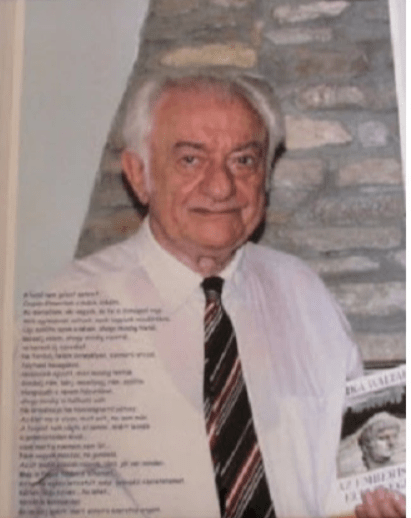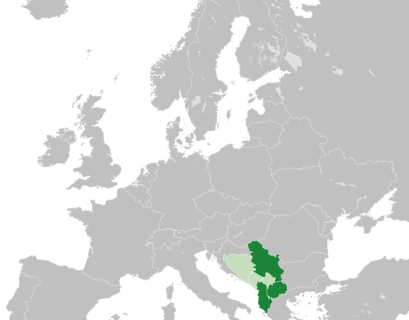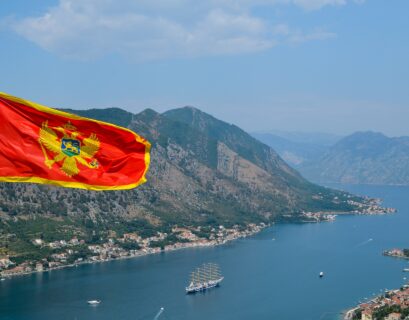By Etleva Lala
“István Schütz” is the name that dominated the Hungarian-speaking world in the second half of the twentieth century with regard to Albanian studies and the best representative of Hungarian Albanology in this period. Schütz was the first who introduced the Albanian language to Hungarian students and other interested parties who wanted to learn Albanian, by teaching and creating a unique method of learning Albanian, which respects very much the Hungarian mentality of learning a language. He had dedicated 62 years of his life to the teaching and studying of the Albanian language and culture, when he passed away on 27 November 2010 at the age of 87 years old.
With his extensive activity Schütz is a follower of the tradition of Hungarian albanology, where such prominent names as Ludwig Thallóczy, Franz Nopcsa, György Daniel, Lájos Tamás, etc. stand out. In this regard, he was quite well-acquainted with the Austro-Hungarian scholarship, especially with regard to the language. Yet, he was a pioneer in teaching Albanian to the Hungarian students and is the first probably to have a unique contribution in this direction, preparing linguistically a generation of Hungarian scholars, capable to pursue Albanian and Balkan studies using Albanian as a source language.
He was a self-made Albanologist, because not only he learned Albanian like the “Gypsi learns his musical instrument,” without any books at all, but he also studies Albanian culture and history in this way. Yet he was persistent and had an extraordinary patience with his research, which due to the time he was living in, was facing various challenges.
Born on 27 March 1923 in a Romanian village at the Hungarian border, Schütz told proudly that the village school attached great importance to foreign languages, both classical and modern. The young Schütz, who grew up with Romanian, Hungarian, and German, graduated from this school with very good knowledge not only in Hungarian and Romanian, but also in Latin and French. The dynamics between this small environment and his Budapest city life would probably attract Hungarian scholars, who are interested into center and peripheries during Communism.
During the Second World War he ended up among the French troops, doing the work of the translator, and after the War he finally settled in Hungary, where he continued his university studies in Hungarian and Latin languages and literature. Schütz was 25 years old and had just finished his higher studies in Hungarian and Latin language and literature, when he came in contact with the first Albanian students who went to Hungary, in 1948, and needed to learn Hungarian as soon as possible. Since they needed a professor to teach them in French or Italian, Schütz was immediately accepted as their teacher of Hungarian, and he immediately started not only to teach them Hungarian, but also to learn Albanian himself. He was employed at the Department of the Romanian Language, where he was also teaching Finnish. This department still holds a lot of materials of Schütz in their archives, which show the multi-linguistic personality of Schütz and his methods.
“I learned Albanian like a gipsy his instrument” – said Schütz when asked how he learned Albanian, and then recounted all his vicissitudes of learning a language for which there was absolutely no dictionary or grammar book to help, but only an invincible passion. The first word he learned from Albanian students, Schütz said in an interview a few months before his death, was the word qukapik woodpecker. In fact, this was the second word after the word mbret, which he had learned during his Latin studies, where his Latin professor had told them, that the name of the emperor in Albanian was wrinkled into mbret. Schütz’s first students did not understand the word woodpecker in any of the many languages Schütz knew, and hence he drew it on the blackboard. All his Albanian students called it qukapik. And so he continued: with pieces of paper with Albanian words in his pockets. Schütz made the following statement in the interview: “instead of the Finno-Ugric linguistics I developed a love for life with the Albanian language, literature and culture.”
It were precisely those pieces of paper in his pockets, those which grew over the days and months and would multiply to hundreds of thousands, a material basis on which Schütz compiled the first Albanian-Hungarian dictionary published in 1953 with the editor-in-chief the linguist Lájos Tamàs as the publisher of Hungarian Academy of Sciences.[1] That dictionary was a small one, compared to the multi-volume dictionary compiled later by Schütz, still waiting to be published. This new Hungarian-Albanian dictionary contains over 80,000 words, and has about 1,700 pages, according to his declarations. The dictionary also contains words that many of the younger generation no longer know. It is therefore an encyclopedic dictionary of the Albanian language, which would be a great basis for the Albanian encyclopedia planned by the Albanian Academy of Sciences.
Albanian as a foreign language. In addition to the lexicographical work, Schütz has also compiled and published a textbook of the Albanian language for Hungarians, a textbook, which was published in Budapest in 2002 by the “Balassi publishing house. The textbook entitled Albán Nyelvkönyv is in large format and with a red cover with a black eagle in the middle. In 25 lessons the author has given grammatical knowledge and a basic group of words (about 4 thousand words), which give the student sufficient competence to understand the texts and to speak Albanian. Knowledge of the language here is masterfully combined with knowledge of Albanian culture and civilization. Special about this textbook is the approach of Schütz towards the cases of the Albanian language. By turning upside down the declension of the substantives, he actually frees the Albanian language from the artificial vessels, in which Albanian was forced to fit in. This is an extremely interesting approach for the linguists.
Personal Contacts: Schütz was regularly participating in numerous meetings in Tirana, Prishtina and Budapest, and took active part in discussing various topics, not only linguistic, but also in other disciplines, like history, ethnology, folklore, literature, translations, etc., where he excelled for a deep knowledge of erudite speaking in a pure Tosk Albanian, which made it quite difficult for those who did not know him, to understand that he was not Albanian.
Schütz devoted himself to teaching the Albanian language to Hungarians, and even to other interested foreigners. Due to political circumstances, the regular institutional teaching of Albanian actually started only in 1983 at Lóránt Eötvös [ELTE] University in Budapest, which gathered those interested in this language. Schütz summarized his teaching activity and experience with the Albanian language in Hungary, in the article “Mësimi i Gjuhës shqipe në Hungari” (Teaching Albanian in Hungary,) published in “Gjuha Jone”, a periodical of the Academy of Sciences of Albania, Tirana, 2000, pp. 106-114.
Albanian Dictionary The first dictionary was written in 1913 by dr. Laszlo Zoltàn, who had already published a small Albanian-Hungarian dictionary with circa 2000 words, for touristic purposes. In 1953 the Albanian-Hungarian dictionary was published in Budapest by the Hungarian Academy of Sciences. Chief editor was Lajos Tamàs, and Istvàn Schütz was one of the editors. It was the time, when the academies of the Eastern Camp tried to establish long-term relations with each-other. The Albanian-Hungarian dictionary was thus also edited by the scholars of the Albanian Institute of Sciences, namely linguists, like prof. Aleksandër Xhuvanit. A year later, 1954, the first Albanian dictionary was also published in Albania, and one of the editors of this publication was also Anton Krajni, who was good in Hungarian too.
Schütz has also contributed in this dictionary with his two best students, Zef Rakacolli and Kudret Velça, who created a tradition of these dictionaries in Albania afterwards. The dictionary had two good reviews written by Jup Kastrati in the pediodical “Nëndori”, 1955, no. 2, and by Pashko Geci and Anton Krajni in “Buletin për shkencat shoqërore”, in 1956, no. 3. The reviewers consider this dictionary as a qualitative step towards the Albanian-foreign language lexicography, point out the values of this dictionary, such as the rich vocabulary, and the scholarly criteria on which it was built. The illustrations of the meanings of words and phrases and/or their exact equivalent in the Hungarian language. This is still a milestone for many dictionaries in Albania.
Folklore: In addition to teaching Albanian, Schütz was very much attracted by the Albanian folklore and literature, and not only by the proverbs of Albanian language, which he kept handy in his mouth, but also used often in his translations into Hungarian. Since the ’50s he studied Albanian folklore in the first place, reading all the volumes of the series “Visaret e kombit” that were to be found in the Hungarian libraries. He also tried to build his own theories based on the Albanian folklore, which is a source for further study.
Translations. Schütz began to publish his first translations of Albanian literature in Hungarian quite early: in 1952 he published the Anthology of Albanian poets, in 1957 a volume of folk tales “The prettiest of the earth”, in 1960 the novel Tana by Fatmir Gjata. In 1968 he published a volume of Albanian folk poetry entitled “Pomegranate is blooming,” prepared before the freezing of interstate relations. “The General of the Dead Army” was also introduced to the Hungarian reader in 1972 through his translation, and this work was republished in 1975.
In 1978 he translated another work from another genre: that of humor. “The Career of Mr. Maksut” of Qamil Buxheli, however, caused him a lot of political problems. In 1994, Öskönyv’s volume published six short stories by young Albanian writers, translated by Schütz. In 1998, in a special issue of the Hungarian Writers’ League Magyar Naplo, he published an overview of the rebirth and the development of Albanian literature, on its path of hardships during the dictatorship and on its recovery after the change of regime. In this issue he also translated some short stories and poems as well as an interview of Rexhep Qosja on the unified Albanian literary (taken from the magazine Universi shqiptar i librit). The magic of the imagination of Kadare certainly captured also Schütz and he translated and published the essay “Aeschylus, this great loser”; At the same time, he prepared also the translation and publication into Hungarian of some other works of Kadare.
István Schütz dealt not only with the Albanian language, linguistics and translations, but also with the history of the Albanian people. He published several reactions to anti-Albanian theses. He was an expressed critic of the thesis of Gottfried Schramm, on the ethno-genesis of the Romanians and then on the beginnings of Christianity among the Albanians. On top of that, in 1989, Schütz published in the magazine Studime filologjike (no. 3) the article “Albanian-Romanian linguistic similarities and ethnic continuity in Kosovo” with the subtitle “Thoughts on Gottfried Schramm’s monograph” Early Fates of the Romanians (published 1986-1987).
In the Symposium “Christianity among Albanians” (Tirana, 16-19.11.1999) Schütz delivered the paper “The Conversion and the Origins of the Albanians”, where he presented his remarks about Gottfried Schramm’s latest monograph “The Beginnings of Christianity among Albanians – The Early Conversion of the Faith and Its Further Consequences” (1994) as well as another work, published after the death of Romanian epigraphist II Russu “Thracian origin of Romanians and Albanians.”
Schütz fully agrees with the German scholar’s conclusion in the first monograph that examining the similarities between Albanian and Romanian languages gives the impression that the ancestors of today’s Albanians and Romanians lived for a longer time in the same province and that the key to the enigma of Romanian ethno-genesis is Albanian. He disagrees with the German scholar precisely in that, due to some erroneous etymologies, he does not recognize the continuity of the Albanian ethnos in today’s lands, but makes Albanians come from the interior of the Balkans, from the southwestern part of present-day Bulgaria and Southeast Macedonia. According to Schramm, the Albanians have their source from the Thracian tribe of the Beses, who were converted to Christianity by Bishop Niketa in the 15th century. IV, created the Thracian script and translated the necessary liturgical texts. From the 9th century this tribe escaped the persecution of the Bulgarian pagan tsars, after seeking refuge with the Byzantine emperor and settled in the hinterland of Durrës. This theory, according to him, has no historical, archaeological, ethnographic or linguistic support.
In 1998, on the 50th anniversary of his first meeting with Albanians and the Albanian language, Schütz was decorated with the Order “Naim Frashëri” by the President of the Republic of Albania for his extensive Albanological activity. On that occasion, he made an Albanian-Hungarian promise, that he would continue to work with all his energy for the Albanian language and for the improvement of the relations between these two peoples. He kept his promise until the last day of his life, becoming one of the most trusted friends of the Albanians, as Emil Lafe would put it.
[1] Levente NAGY, “Un studioso ungherese di Albanologia: Lajos Tamás” Studime 21, (2014): 249-263. http://www.ashak.org/repository/docs/Studime_21__komplet_554123.pdf










